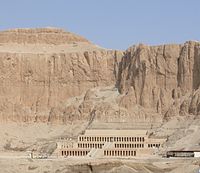- Mortuary Temple of Hatshepsut
-
The Mortuary Temple of Queen Hatshepsut, the Djeser-Djeseru ("Holy of Holies"), is located beneath the cliffs at Deir el Bahari on the west bank of the Nile near the Valley of the Kings in Egypt. The mortuary temple is dedicated to the sun god Amon-Ra and is located next to the mortuary temple of Mentuhotep II, which served both as an inspiration, and later, a quarry. It is considered one of the "incomparable monuments of ancient Egypt." [1] The temple was the site of the massacre of 62 people, mostly tourists, by Islamist extremists that took place on 17 November 1997.
Contents
Architecture
Hatshepsut's chancellor, royal architect, and possible lover Senemut oversaw construction and most likely designed the temple.[2] Although the adjacent, earlier mortuary temple of Mentuhotep was used as a model, the two structures are nevertheless significantly different in many ways. Hatshepsut's temple employs a lengthy, colonnaded terrace that deviates from the centralised structure of Mentuhotep’s model – an anomaly that may be caused by the decentralized location of her burial chamber.[3] There are three layered terraces reaching 97 feet tall. Each 'story' is articulated by a double colonnade of square piers, with the exception of the northwest corner of the central terrace, which employs Proto Doric columns to house the chapel. These terraces are connected by long ramps which were once surrounded by gardens with foreign plants including frankincense and myrrh trees.[4] The layering of Hatshepsut’s temple corresponds with the classical Theban form, employing pylons, courts, hypostyle hall, sun court, chapel and sanctuary.
Sculpture and Relief
The relief sculpture within Hatshepsut’s temple recites the tale of the divine birth of a female pharaoh – the first of its kind. The text and pictorial cycle also tell of an expedition to the Land of Punt, an exotic country on the Red Sea coast. While the statues and ornamentation have since been stolen or destroyed, the temple once was home to two statues of Osiris, a sphinx avenue as well as many sculptures of the Queen in different attitudes – standing, sitting, or kneeling. Many of these portraits were destroyed at the order of her resentful stepson Thutmose III after her death.[5]
Historical Influence
Hatshepsut’s temple is considered the closest Egypt came to Classical architecture.[6] Representative of New Kingdom funerary architecture, it both aggrandizes the pharaoh and includes sanctuaries to honor the gods relevant to her afterlife.[7] This marks a turning point in the architecture of Ancient Egypt, which forsook the megalithic geometry of the Old Kingdom for a temple which allowed for active worship, requiring the presence of participants to create the majesty. The linear axiality of Hatshepsut’s temple is mirrored in the later New Kingdom temples.
The architecture of the original temple has been considerably altered as a result of misguided reconstruction in the early twentieth century AD.See also
- Hatshepsut
- Deir el Bahari
- Luxor massacre
References
- ^ Trachtenberg, Marvin; Isabelle Hyman (2003). Architecture, from Prehistory to Postmodernity. Italy: Prentice-Hall Inc.. pp. 71. ISBN 978-0810906075.
- ^ Kleiner & Mamiya (2006). Gardner's art through the ages : the western perspective Volume I (12th ed. ed.). Victoria: Thomson/Wadsworth. p. 56. ISBN 0495004790.
- ^ Trachtenberg & Hyman (2003). Architecture, from Prehistory to Postmodernity. Italy: Prentice-Hall Inc. pp. 71.
- ^ Kleiner & Mamiya (2006). Gardner's art through the ages : the western perspective Volume I (12th ed. ed.). Victoria: Thomson/Wadsworth. pp. 56. ISBN 0495004790.
- ^ Kleiner & Mamiya (2006). Gardner's art through the ages : the western perspective Volume I (12th ed. ed.). Victoria: Thomson/Wadsworth. pp. 57. ISBN 0495004790.
- ^ Trachtenberg & Hyman (2003). Architecture, from Prehistory to Postmodernity. Italy. pp. 71.
- ^ Nigel; Strudwick, Helen (1999). Thebes in Egypt : a guide to the tombs and temples of ancient Luxor (1. publ. ed.). Ithaca, NY: Cornell Univ. Press. ISBN 0801436931.
Coordinates: 25°44′18″N 32°36′24″E / 25.738266°N 32.606588°E
Categories:- 15th-century BC architecture
- Luxor
- Theban Necropolis
Wikimedia Foundation. 2010.




